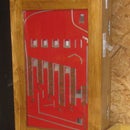Introduction: Solar LED Mushrooms
The Solar LED mushrooms took a little experimentation to get the finished result in the above photo and required a mixture of clear and white silicone for the heads. Using only white made the heads dark.
Supplies
Piece of suitable, rotten looking, piece of timber from forest.
Wood worm treatment for wood
Varnish
1.2mm Steel PVC Garden wire
0.5mm black\red wire
White silicon
Clear silicon
Cling Film
Set of white solar power LED lights - I used a set where the wire was broken but solar unit was working
Electrical connector strips
Step 1: Preparing Wood
I cleaned and scraped the timber to remove any rotten pieces of wood, treated for woodworm and once dried out added several coats of varnish.
Step 2: Creating Each Mushroom
The length of LED's I had were cut in middle, between each LED. This was stripped back to lengths of 50mm which were soldered to 300mm lengths of red\black 0.5mm wire. Before soldering each LED was tested to output wires from solar unit to confirm positive or negative end of each LED. 1.2mm garden wire was twisted around the bottom of the LED and down along - lengths of 80mm to 100mm. Red was connected to Positive side of LED. These cables were kept straight and laid over a piece of cling film. White silicone was then run all along the twisted wires and the cling film was rolled to create a long thin sausage shape. The silicone was gently molded to ensure that the wires were fully encased. Note that the silicone helps seal solder joint from rain and provides insulation from other wires.
These were left to dry for a couple of days. After that time the stalks could be bent into the general shape of the mushroom stalk for testing.
To create the mushroom head, a 50:50 mixture of clear and white silicone was placed onto a piece of cling film about a third of the way along. The cling film was folded over and the silicone moulded into a pancake shape to ensure even thickness. These were then shaped over handles of different sizes (broom and chisel) so that the mushroom cap shape was formed.
These shapes were left to dry for 48 hours as cling film delayed curing.
Once dry, the mushroom heads were glued to the LED end of the stalks using clear silicone.
Step 3: Assembling the Mushrooms
Holes were drilled into the wood where I wanted mushrooms to 'sprout' from. The base of the stalks were tested before using and then fed into the wood. Each mushroom was glued into place on the underside of the wood with clear silicone (just in case any was visible in error).
After a few days, I then cut the black and red wires to the same length in several places and joined them using electrical connector blocks. Once testing confirmed all wiring successful I added more silicone to help hold the wires and connectors to prevent accidental damage from tugs and pulls.
That was again left to cure for a few days before taking finished product outside and adjusting\bending stalks to get best effect.
Note that the LEDs now stay on all night as there are less LEDs than what the package originally came with.











